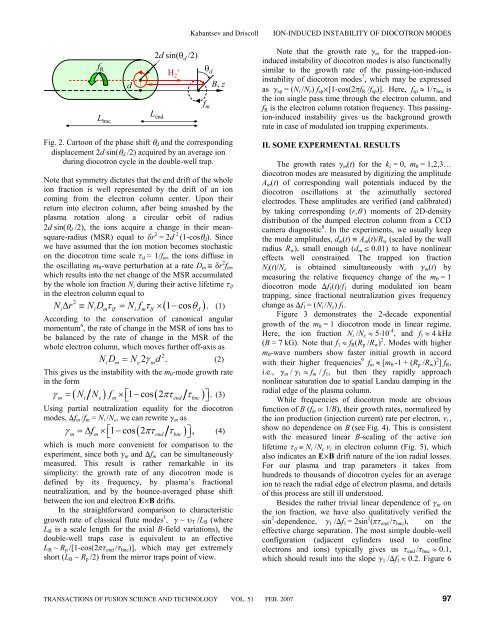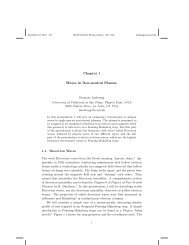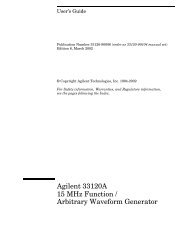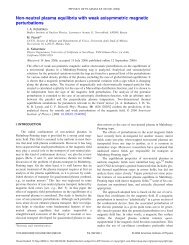ion-induced instability of diocotron modes in electron - Nonneutral ...
ion-induced instability of diocotron modes in electron - Nonneutral ...
ion-induced instability of diocotron modes in electron - Nonneutral ...
Create successful ePaper yourself
Turn your PDF publications into a flip-book with our unique Google optimized e-Paper software.
f Rd2d s<strong>in</strong>(θ d /2)H 2+L bncL end∏θ dB, zFig. 2. Cartoon <strong>of</strong> the phase shift θ d and the correspond<strong>in</strong>gdisplacement 2d s<strong>in</strong>(θ d /2) acquired by an average <strong>ion</strong>dur<strong>in</strong>g <strong>diocotron</strong> cycle <strong>in</strong> the double-well trap.Note that symmetry dictates that the end drift <strong>of</strong> the whole<strong>ion</strong> fract<strong>ion</strong> is well represented by the drift <strong>of</strong> an <strong>ion</strong>com<strong>in</strong>g from the <strong>electron</strong> column center. Upon theirreturn <strong>in</strong>to <strong>electron</strong> column, after be<strong>in</strong>g smashed by theplasma rotat<strong>ion</strong> along a circular orbit <strong>of</strong> radius2d s<strong>in</strong>(θ d /2), the <strong>ion</strong>s acquire a change <strong>in</strong> their meansquare-radius(MSR) equal to δr 2 = 2d 2 (1-cosθ d ). S<strong>in</strong>cewe have assumed that the <strong>ion</strong> mot<strong>ion</strong> becomes stochasticon the <strong>diocotron</strong> time scale t d = 1/f m , the <strong>ion</strong>s diffuse <strong>in</strong>the oscillat<strong>in</strong>g m θ -wave perturbat<strong>ion</strong> at a rate D m ª δr 2 f m ,which results <strong>in</strong>to the net change <strong>of</strong> the MSR accumulatedby the whole <strong>ion</strong> fract<strong>ion</strong> N i dur<strong>in</strong>g their active lifetime t lf<strong>in</strong> the <strong>electron</strong> column equal to( )N Δr ≡ N D τ = N f τ × 1− cos θ . (1)2i i m lf i m lf dAccord<strong>in</strong>g to the conservat<strong>ion</strong> <strong>of</strong> canonical angularmomentum 6 , the rate <strong>of</strong> change <strong>in</strong> the MSR <strong>of</strong> <strong>ion</strong>s has tobe balanced by the rate <strong>of</strong> change <strong>in</strong> the MSR <strong>of</strong> thewhole <strong>electron</strong> column, which moves further <strong>of</strong>f-axis as2N D = N 2 γ d .(2)i m e mThis gives us the <strong><strong>in</strong>stability</strong> with the m θ -mode growth rate<strong>in</strong> the form( N N ) f ⎡ ( )γm=i e m× ⎣1 −cos 2 πτend τbnc⎤⎦ . (3)Us<strong>in</strong>g partial neutralizat<strong>ion</strong> equality for the <strong>diocotron</strong><strong>modes</strong>, Df m /f m = N i /N e , we can rewrite g m as( )Kabantsev and Driscollγm=Δ fm× ⎡⎣ 1−cos 2 πτend τbnc⎤⎦ , (4)which is much more convenient for comparison to theexperiment, s<strong>in</strong>ce both g m and Df m can be simultaneouslymeasured. This result is rather remarkable <strong>in</strong> itssimplicity: the growth rate <strong>of</strong> any <strong>diocotron</strong> mode isdef<strong>in</strong>ed by its frequency, by plasma’s fract<strong>ion</strong>alneutralizat<strong>ion</strong>, and by the bounce-averaged phase shiftbetween the <strong>ion</strong> and <strong>electron</strong> EμB drifts.In the straightforward comparison to characteristicgrowth rate <strong>of</strong> classical flute <strong>modes</strong> 1 , g ~ υ T /L B (whereL B is a scale length for the axial B-field variat<strong>ion</strong>s), thedouble-well traps case is equivalent to an effectiveL B ~ R p /[1-cos(2pt end /t bnc )], which may get extremelyshort (L B ~ R p /2) from the mirror traps po<strong>in</strong>t <strong>of</strong> view.f mION-INDUCED INSTABILITY OF DIOCOTRON MODESNote that the growth rate g m for the trapped-<strong>ion</strong><strong><strong>in</strong>duced</strong><strong><strong>in</strong>stability</strong> <strong>of</strong> <strong>diocotron</strong> <strong>modes</strong> is also funct<strong>ion</strong>allysimilar to the growth rate <strong>of</strong> the pass<strong>in</strong>g-<strong>ion</strong>-<strong><strong>in</strong>duced</strong><strong><strong>in</strong>stability</strong> <strong>of</strong> <strong>diocotron</strong> <strong>modes</strong> 7 , which may be expressedas g sp = (N i /N e ) f sp μ[1-cos(2pf R /f sp )]. Here, f sp ≈ 1/t bnc isthe <strong>ion</strong> s<strong>in</strong>gle pass time through the <strong>electron</strong> column, andf R is the <strong>electron</strong> column rotat<strong>ion</strong> frequency. This pass<strong>in</strong>g<strong>ion</strong>-<strong><strong>in</strong>duced</strong><strong><strong>in</strong>stability</strong> gives us the background growthrate <strong>in</strong> case <strong>of</strong> modulated <strong>ion</strong> trapp<strong>in</strong>g experiments.II. SOME EXPERMENTAL RESULTSThe growth rates g m (t) for the k z = 0, m θ = 1,2,3…<strong>diocotron</strong> <strong>modes</strong> are measured by digitiz<strong>in</strong>g the amplitudeA m (t) <strong>of</strong> correspond<strong>in</strong>g wall potentials <strong><strong>in</strong>duced</strong> by the<strong>diocotron</strong> oscillat<strong>ion</strong>s at the azimuthally sectoredelectrodes. These amplitudes are verified (and calibrated)by tak<strong>in</strong>g correspond<strong>in</strong>g (r,θ ) moments <strong>of</strong> 2D-densitydistribut<strong>ion</strong> <strong>of</strong> the dumped <strong>electron</strong> column from a CCDcamera diagnostic 8 . In the experiments, we usually keepthe mode amplitudes, d m (t) ª A m (t)/R w (scaled by the wallradius R w ), small enough (d m § 0.01) to have nonl<strong>in</strong>eareffects well constra<strong>in</strong>ed. The trapped <strong>ion</strong> fract<strong>ion</strong>N i (t)/N e is obta<strong>in</strong>ed simultaneously with g m (t) bymeasur<strong>in</strong>g the relative frequency change <strong>of</strong> the m θ = 1<strong>diocotron</strong> mode Df 1 (t)/f 1 dur<strong>in</strong>g modulated <strong>ion</strong> beamtrapp<strong>in</strong>g, s<strong>in</strong>ce fract<strong>ion</strong>al neutralizat<strong>ion</strong> gives frequencychange as Df 1 = (N i /N e ) f 1 .Figure 3 demonstrates the 2-decade exponentialgrowth <strong>of</strong> the m θ = 1 <strong>diocotron</strong> mode <strong>in</strong> l<strong>in</strong>ear regime.Here, the <strong>ion</strong> fract<strong>ion</strong> N i /N e º 5ÿ10 -4 , and f 1 º 4 kHz(B = 7 kG). Note that f 1 º f R (R p /R w ) 2 . Modes with higherm θ -wave numbers show faster <strong>in</strong>itial growth <strong>in</strong> accordwith their higher frequencies 9 f m ≈ [m θ -1 + (R p /R w ) 2 ] f R ,i.e., g m / g 1 º f m / f 1 , but then they rapidly approachnonl<strong>in</strong>ear saturat<strong>ion</strong> due to spatial Landau damp<strong>in</strong>g <strong>in</strong> theradial edge <strong>of</strong> the plasma column.While frequencies <strong>of</strong> <strong>diocotron</strong> mode are obviousfunct<strong>ion</strong> <strong>of</strong> B (f m ∂ 1/B), their growth rates, normalized bythe <strong>ion</strong> product<strong>ion</strong> (<strong>in</strong>ject<strong>ion</strong> current) rate per <strong>electron</strong>, n i ,show no dependence on B (see Fig. 4). This is consistentwith the measured l<strong>in</strong>ear B-scal<strong>in</strong>g <strong>of</strong> the active <strong>ion</strong>lifetime t lf ≡ N i /N e n i <strong>in</strong> <strong>electron</strong> column (Fig. 5), whichalso <strong>in</strong>dicates an EμB drift nature <strong>of</strong> the <strong>ion</strong> radial losses.For our plasma and trap parameters it takes fromhundreds to thousands <strong>of</strong> <strong>diocotron</strong> cycles for an average<strong>ion</strong> to reach the radial edge <strong>of</strong> <strong>electron</strong> plasma, and details<strong>of</strong> this process are still ill understood.Besides the rather trivial l<strong>in</strong>ear dependence <strong>of</strong> g m onthe <strong>ion</strong> fract<strong>ion</strong>, we have also qualitatively verified thes<strong>in</strong> 2 -dependence, g 1 /Df 1 = 2s<strong>in</strong> 2 (pt end /t bnc ), on theeffective charge separat<strong>ion</strong>. The most simple double-wellconfigurat<strong>ion</strong> (adjacent cyl<strong>in</strong>ders used to conf<strong>in</strong>e<strong>electron</strong>s and <strong>ion</strong>s) typically gives us t end /t bnc º 0.1,which should result <strong>in</strong>to the slope g 1 /Df 1 º 0.2. Figure 6TRANSACTIONS OF FUSION SCIENCE AND TECHNOLOGY VOL. 51 FEB. 2007 97








![WORKSHOP PARTICIPANTS LIST [pdf] - UC San Diego](https://img.yumpu.com/35298899/1/190x245/workshop-participants-list-pdf-uc-san-diego.jpg?quality=85)
